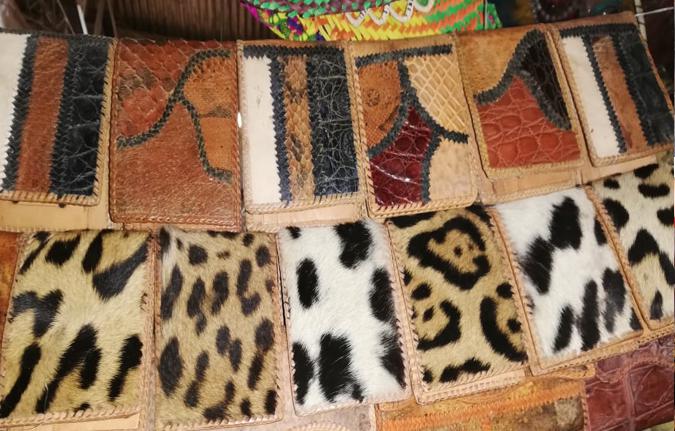Melissa Arias
A recent upsurge of trade in jaguar body parts has alarmed the conservation community, yet very little is known about the scale, drivers and impacts of this threat to Latin America’s most iconic wild-cat. The aim of this project is to support jaguar conservation decision-making by collecting, analysing and interpreting the evidence available on jaguar trade. Moreover, the project will assess the uncertainty throughout the jaguar trade chain, and provide recommendations for how decision makers across countries can use jaguar trade evidence to make conservation decisions.

Wallets. ©Miguel Fernandez and Melissa Arias.
Jaguars (Panthera onca) were heavily hunted for the fashion industry in the early to mid-20th century. However, since the prohibition of this trade with the ratification of CITES in 1975, jaguars have slowly recovered throughout most of their current range. After being enlisted in CITES Appendix I, the main threats to jaguars switched from commercial trade to habitat encroachment, connectivity loss, and conflict with humans. However, new evidence suggests that the trade in jaguar body parts is resurging. In Bolivia alone, 344 jaguar fangs destined for China were seized by local authorities from 2014 to 2016, implying the killing of at least 87 jaguars. Similarly, poached jaguar carcasses and the commercialization of jaguar body parts have been reported throughout Mesoamerica, Brazil, Suriname and Venezuela. Conservationists believe that this rise in jaguar trade could be driven by Chinese Traditional Medicine, which attributes healing powers to felid body parts. Likewise, jaguar trade could be a by-product of increased human-jaguar conflict and demand at a domestic level.
While there is enough evidence to prove that jaguar trade is occurring at the domestic and international level, much uncertainty remains about its scale, impacts and drivers. However, due to its potentially devastating impacts on wild jaguar populations, conservationists and governments at a local and international level are starting to recognize the importance of elevating this threat as a priority for the species.
The goal of this project is to support jaguar conservation policies and interventions by building an evidence-based approach for addressing jaguar trade. This begins by collecting and organizing the evidence that exists on jaguar trade, describing its attributes along the different levels of the trade chain while also identifying the main gaps and geographical biases in the information. Next, the project will evaluate the quality of the evidence on jaguar trade, and its relevance in terms of what it reveals about the impacts of illegal trade on jaguar populations. Moreover, the project will provide insights about how decision-makers are currently using the evidence and considering its underlying uncertainty to address jaguar trade. Finally, the project will carry out a pilot study, to determine whether indirect questioning techniques can be used to estimate the prevalence of jaguar trade in local communities in Bolivia. Through these steps, the project will provide an interpretation of the evidence on jaguar trade, making it accessible and convenient to inform future jaguar conservation actions.